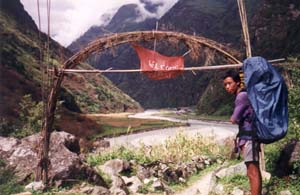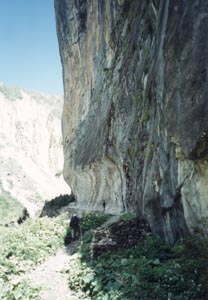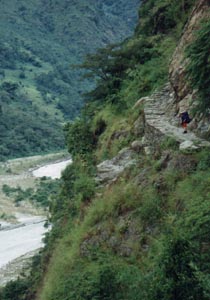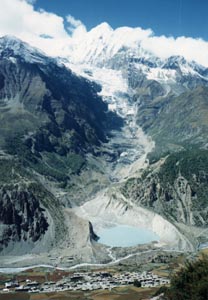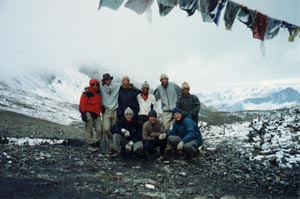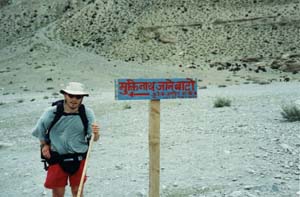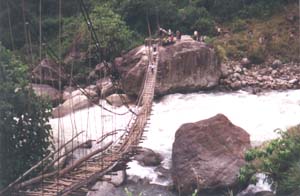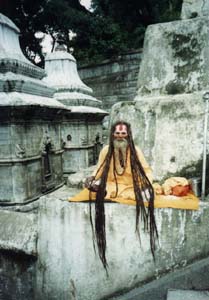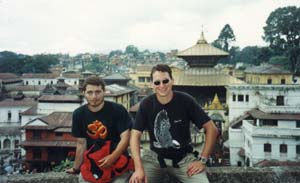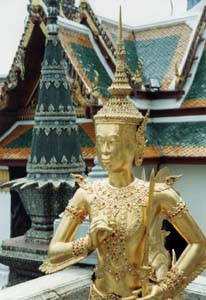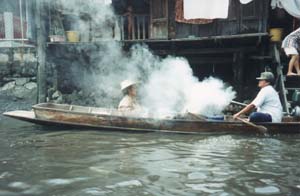|
annapurna
trek
see more photos here |
|||||||||||||||||||
| And
now onto the trip
for your viewing pleasure, all the pictures are linked to larger images |
|||||||||||||||||||
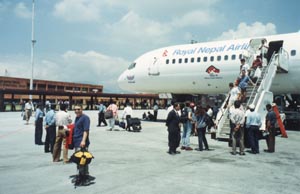 Things
started uneventfully enough with a short flight from San Diego up to San
Jose where I met up with my fellow trekker, Colin. That was Friday, September
4th, and the following morning, we boarded a plane for Narita, Japan.
Some 11 hours later, we landed and gratefully left the plane for a three
hour layover before boarding a plane to Bangkok, Thailand for another
six hour flight. We arrived late and wisely decided to forgo the joy of
sleeping on the airport terminal floor for a nearby hotel and 5 hours
of rest. The following morning, we hopped on a plane for our final leg
of the journey to Kathmandu. Things
started uneventfully enough with a short flight from San Diego up to San
Jose where I met up with my fellow trekker, Colin. That was Friday, September
4th, and the following morning, we boarded a plane for Narita, Japan.
Some 11 hours later, we landed and gratefully left the plane for a three
hour layover before boarding a plane to Bangkok, Thailand for another
six hour flight. We arrived late and wisely decided to forgo the joy of
sleeping on the airport terminal floor for a nearby hotel and 5 hours
of rest. The following morning, we hopped on a plane for our final leg
of the journey to Kathmandu.
Having
finally made it to Nepal, we thought the worst of our travel behind
us, how wrong we were! After a day spent in Kathmandu arranging our
trekking permits and bus fare, or to be more accurate, paying a hefty
bribe for someone else to take care of these things for us, we boarded
a bus that defies description for a trip that similarly defied description.
Suffice to say that the trip to the trail head at Bessisahar took two
days instead of the advertised one and involved a landslide causing
a five hour traffic jam, a night spent in the charming town of Dumre,
complete with the worst bedbugs ever encountered, and lastly, a bone
jarring journey over rutted muddy roads and rivers that would destroy
most of the sport utilities on the road today. Terrible as this all
may sound, it was really a terrific adventure and while, I'm not eager
to repeat those parts again, they were fun. So it was a real adventure
to even get to the trailhead, the starting point for our trek around
the Annapurna Himal. The first day was a long hard hike in the blazing sun along a trail that followed the Marsayandi river and climbed the hills through rice paddies and small settlements. A combination of heat, dehydration, a ten hour hike, and a heavy pack conspired to kill me and nearly did as heat exhaustion set in that evening and I spent the evening sick. The following day I wasn't much better so we took a short hike and stopped a few hours up the trail for lunch and stayed the day. While I recovered, Colin made friends with a Tibetan innkeeper and arranged us a porter: a slight man of 20 named Doni who, with a huge pack, still managed to beat us up every trail. The feelings of weakness and guilt that we didn't carry our own packs quickly gave way to the realization that, freed of our heavy packs, we were enjoying the trek much more and this was a vacation after all. Plus our porter was thrilled to be making good money.
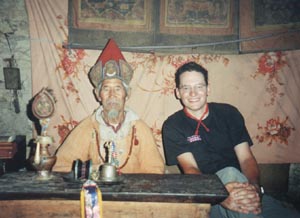 gave
way to open valleys above the tree-line with magnificent panoramic views
of the mountains which, no matter how high we climbed, still seemed (and
really are) beyond reach. We took a rest day to adjust to the altitude
on the tenth day at the village of Manang (elevation 11600 feet) located
at the base of Gangapurna, a 23000 foot peak with a glacier that drains
to a lake adjacent to the village. On our "day off", we climbed
a few thousand feet up to a Buddhist temple nestled in a cave high above
Manang. There we were blessed by a Lama and promised safe passage over
the Thorung La pass. We had tea, paid a generous donation, and left pictures
of ourselves on an altar with many others who had made this "pilgrimage".
So now there is a cave high in the Himalayas with my picture in it. Cool
huh? gave
way to open valleys above the tree-line with magnificent panoramic views
of the mountains which, no matter how high we climbed, still seemed (and
really are) beyond reach. We took a rest day to adjust to the altitude
on the tenth day at the village of Manang (elevation 11600 feet) located
at the base of Gangapurna, a 23000 foot peak with a glacier that drains
to a lake adjacent to the village. On our "day off", we climbed
a few thousand feet up to a Buddhist temple nestled in a cave high above
Manang. There we were blessed by a Lama and promised safe passage over
the Thorung La pass. We had tea, paid a generous donation, and left pictures
of ourselves on an altar with many others who had made this "pilgrimage".
So now there is a cave high in the Himalayas with my picture in it. Cool
huh?
Fifteen
days after we start, we finish our trek at the town of Beni where we
find transportation to the resort town of Pokhara and by 9pm that evening,
we're in a hotel with a TV and hot water, imagine the luxury. We relax
in Pokhara for several days, enjoying the slow pace and the she
So now, a month later, what have I learned? Did this trip, this adventure, change me? The short answer is no. The slightly longer answer (sparing you the really long answer which would be the 100 pages I wrote in my journal on the trip!) is that I had lots of time on the trip to think about my life. The trip was a nice retreat from work and basically every aspect of my life and I had opportunity to come to miss and appreciate my life here. So if anything, I came back anxious to resume my old life. Somehow, the daily complaints about work and home seem paltry in comparison to the struggles faced by the people living in the hills of Nepal. And yet, somehow, in the shadows of the Himalayas, facing a terrible poverty they manage to live the happy contented life that escapes many of us here. Perhaps there is a lesson there, something about taking the time to appreciate what we do have and remember to enjoy ourselves. I left San Diego a poor student and returned to the same income and yet I know now how rich I am. No, I'm not being philosophical, I'm talking about moneywe're rich here and maybe I should take some time to stop worrying about money and instead focus on other things. And then I remember that a Coke costs a bit more than 15 cents here. |
|||||||||||||||||||
